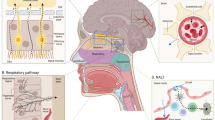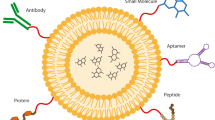Abstract
Purpose. The purpose of this work was to determine mrp1-mediated efflux across the luminal membrane of endothelial cells at the blood-brain barrier (BBB) in mice.
Methods. The transport of radiolabeled etoposide, 17β-estradiol-D-17β-glucuronide (E217βG), vincristine, and doxorubicin across the BBB of mrp1(–/–) and wild-type mice was evaluated by in situ brain perfusion. Etoposide transport was also determined in P-glycoprotein-deficient mdr1a(–/–) mice perfused with both etoposide and mrp1 inhibitors like probenecid or MK571. Cerebral vascular volume was determined by co-perfusion with labeled sucrose.
Results. Sucrose perfusion indicated that the vascular space was close to normal in all the studies, indicating that the BBB remained intact. The transport of etoposide, E217βG, vincristine, and doxorubicin into the brain was not affected by the lack of mrp1. Trans-efflux studies in mrp1-deficient mice with etoposide and E217βG confirmed that mrp1 was not involved in the efflux of these substrates across the BBB. There was also a significant P-gp-mediated efflux of etoposide in studies with P-glycoprotein-deficient mdr1a(–/–) mice. Perfusion of mdr1a(–/–) mice etoposide plus probenecid or MK571 did not affect the brain transport of etoposide.
Conclusion. Efflux mediated by mrp1 does not seem to occur across the luminal membrane of the endothelial cells forming the mouse BBB.
Similar content being viewed by others
References
P. Borst, R. Evers, M. Kool, and J. Wijnholds. A family of drug transporters: the multidrug resistance-associated proteins. J. Nat. Cancer Inst. 92:1295–1302 (2000).
T. Eisenblätter and H. J. Galla. A new multidrug resistance protein at the blood-brain barrier. Biochem. Biophys. Res. Commun. 293:1273–1278 (2002).
C. Cordon-Cardo, J. P. O'Brien, D. Casals, L. Rittman-Grauer, J. L. Biedler, M. R. Melamed, and J. R. Bertino. Multidrug resistance gene (P-glycoprotein) is expressed by endothelial cells at blood-brain barrier sites. Proc. Natl. Acad. Sci. USA 86:695–698 (1989).
M. Kool, M. de Haas, G. L. Scheffer, R. J. Scheper, M. J. van Eijk, J. A. Juijn, F. Baas, and P. Borst. Analysis of expression of cMOAT (MRP2), MRP3, MRP4, and MRP5, homologues of the multidrug resistance-associated protein gene (MRP1), in human cancer cell lines. Cancer Res. 57:3537–3547 (1997).
X. Decleves, A. Fajac, J. Lehmann-Che, M. Tardy, C. Mercier, I. Hurbain, J. L. Laplanche, J. F. Bernaudin, and J. M. Scherrmann. Molecular and functional MDR1-Pgp and MRPs expression in human glioblastoma multiforme cell lines. Int. J. Cancer 98:173–180 (2002).
H. Huai-Yun, D. T. Secrest, K. S. Mark, D. Carney, C. Brandquist, W. F. Elmquist, and D. W. Miller. Expression of multidrug resistance-associated protein (MRP) in brain microvessel endothelial cells. Biochem. Biophys. Res. Commun. 243:816–820 (1998).
A. Regina, A. Koman, M. Piciotti, B. El Hafny, M. S. Center, R. Bergmann, P. O. Couraud, and F. Roux. Mrp1 multidrug resistance-associated protein and P-glycoprotein expression in rat brain microvessel endothelial cells. J. Neurochem. 71:705–715 (1998).
V. V. Rao, J. L. Dahlheimer, M. E. Bardgett, A. Z. Snyder, R. A. Finch, A. C. Sartorelli, and D. Piwnica-Worms. Choroid plexus epithelial expression of MDR1 P glycoprotein and multidrug resistance-associated protein contribute to the blood-cerebrospinal-fluid drug-permeability barrier. Proc. Natl. Acad. Sci. USA 96:3900–3905 (1999).
N. Strazielle and J. F. Ghersi-Egea. Demonstration of a coupled metabolism-efflux process at the choroid plexus as a mechanism of brain protection toward xenobiotics. J. Neurosci. 19:6275–6289 (1999).
Y. Zhang, H. Han, W. F. Elmquist, and D. W. Miller. Expression of various multidrug resistance-associated protein (MRP) homologues in brain microvessel endothelial cells. Brain Res. 876:148–153 (2000).
G. Jedlitschky, I. Leier, U. Buchholz, K. Barnouin, G. Kurz, and D. Keppler. Transport of glutathione, glucuronate, and sulfate conjugates by the MRP gene-encoded conjugate export pump. Cancer Res. 56:988–994 (1996).
D. W. Loe, R. G. Deeley, and S. P. Cole. Characterization of vincristine transport by the M(r) 190,000 multidrug resistance protein (MRP): evidence for cotransport with reduced glutathione. Cancer Res. 58:5130–5136 (1998).
Q. Mao, R. G. Deeley, and S. P. Cole. Functional reconstitution of substrate transport by purified multidrug resistance protein MRP1 (ABCC1) in phospholipid vesicles. J. Biol. Chem. 275:34166–34172 (2000).
K. Nagata, M. Nishitani, M. Matsuo, N. Kioka, T. Amachi, and K. Ueda. Nonequivalent nucleotide trapping in the two nucleotide binding folds of the human multidrug resistance protein MRP1. J. Biol. Chem. 275:17626–17630 (2000).
G. Rappa, A. Lorico, R. A. Flavell, and A. C. Sartorelli. Evidence that the multidrug resistance protein (MRP) functions as a co-transporter of glutathione and natural product toxins. Cancer Res. 57:5232–5237 (1997).
G. J. Zaman, J. Lankelma, O. van Tellingen, J. Beijnen, H. Dekker, C. Paulusma, R. P. Oude Elferink, F. Baas, and P. Borst. Role of glutathione in the export of compounds from cells by the multidrug-resistance-associated protein. Proc. Natl. Acad. Sci. USA 92:7690–7694 (1995).
A. H. Schinkel. P-glycoprotein, a gatekeeper in the blood-brain barrier. Adv. Drug Deliv. Rev. 36:179–194 (1999).
C. Dagenais, C. Rousselle, G. M. Pollack, and J. M. Scherrmann. Development of an in situ mouse brain perfusion model and its application to mdr1a P-glycoprotein deficient mice. J. Cereb. Blood Flow Metab. 20:381–386 (2000).
S. Cisternino, C. Rousselle, C. Dagenais, and J. M. Scherrmann. Screening of multidrug-resistance sensitive drugs by in situ brain perfusion in P-glycoprotein-deficient mice. Pharm. Res. 18:183–190 (2001).
A. Lorico, G. Rappa, R. A. Finch, D. Yang, R. A. Flavell, and A. C. Sartorelli. Disruption of the murine MRP (multidrug resistance protein) gene leads to increased sensitivity to etoposide (VP-16) and increased levels of glutathione. Cancer Res. 57:5238–5242 (1997).
Y. Takasato, S. I. Rapoport, and Q. R. Smith. An in situ brain perfusion technique to study cerebrovascular transport in the rat. Am. J. Physiol. 247:H484-H493 (1984).
K. O. Hamilton, E. Topp, I. Makagiansar, T. Siahaan, M. Yazdanian, and K. L. Audus. Multidrug resistance-associated protein-1 functional activity in Calu-3 cells. J. Pharmacol. Exp. Ther. 298:1199–1205 (2001).
A. H. Schinkel. The roles of P-glycoprotein and MRP1 in the blood-brain and blood-cerebrospinal fluid barriers. Adv. Exp. Med. Biol. 500:365–372 (2001).
D. Sugiyama, H. Kusuhara, Y. Shitara, T. Abe, and Y. Sugiyama. Effect of 17 beta-estradiol-D-17 beta-glucuronide on the rat organic anion transporting polypeptide 2-mediated transport differs depending on substrates. Drug Metab. Dispos. 30:220–223 (2002).
D. E. Burgio, M. P. Gosland, and P. J. McNamara. Effects of P-glycoprotein modulators on etoposide elimination and central nervous system distribution. J. Pharmacol. Exp. Ther. 287:911–917 (1998).
J. Wijnholds, E. C. DeLange, G. L. Scheffer, D. J. Van den Berg, C. A. Mol, M. van der Valk, A. H. Schinkel, R. J. Scheper, D. D. Breimer, and P. Borst. Multidrug resistance protein 1 protects the choroid plexus epithelium and contributes to the blood-cerebrospinal fluid barrier. J. Clin. Invest. 105:279–285 (2000).
A. Lorico, A. Bertola, C. Baum, O. Fodstad, and G. Rappa. Role of the Multidrug Resistance Protein 1 in protection from heavy metal oxyanions: investigations in vitro and in MRP1-deficient mice. Biochem. Biophys. Res. Commun. 291:617–622 (2002).
I. Tamai, J. Yamashita, Y. Kido, A. Ohnari, Y. Sai, Y. Shima, K. Naruhashi, S. Koizumi, and A. Tsuji. Limited distribution of new quinolone antibacterial agents into brain caused by multiple efflux transporters at the blood-brain barrier. J. Pharmacol. Exp. Ther. 295:146–152 (2000).
M. Murata, I. Tamai, H. Kato, O. Nagata, and A. Tsuji. Efflux transport of a new quinolone antibacterial agent, HSR-903, across the blood-brain barrier. J. Pharmacol. Exp. Ther. 290:51–57 (1999).
K. Naruhashi, I. Tamai, N. Inoue, H. Muraoka, Y Sai, N. Suzuki, and A. Tsuji. Involvement of multidrug resistance-associated protein 2 in intestinal secretion of grepafloxacin in rats. Antimicrob. Agents Chemother. 46:344–349 (2002).
H. Sasabe, A. Tsuji, and Y. Sugiyama. Carrier-mediated mechanism for the biliary excretion of the quinolone antibiotic grepafloxacin and its glucuronide in rats. J. Pharmacol. Exp. Ther. 284:1033–1039 (1998).
G. Fricker, S. Nobmann, and D. S. Miller. Permeability of porcine blood brain barrier to somatostatin analogues. Br. J. Pharmacol. 135:1308–1314 (2002).
D. S. Miller, S. N. Nobmann, H. Gutmann, M. Toeroek, J. Drewe, and G. Fricker. Xenobiotic transport across isolated brain microvessels studied by confocal microscopy. Mol. Pharmacol. 58:1357–1367 (2000).
X. Decleves, A. Regina, J. L. Laplanche, F. Roux, B. Boval, J. M. Launay, and J. M. Scherrmann. Functional expression of P-glycoprotein and multidrug resistance-associated protein (Mrp1) in primary cultures of rat astrocytes. J. Neurosci. Res. 60:594–601 (2000).
Author information
Authors and Affiliations
Rights and permissions
About this article
Cite this article
Cisternino, S., Rousselle, C., Lorico, A. et al. Apparent Lack of Mrp1-Mediated Efflux at the Luminal Side of Mouse Blood-Brain Barrier Endothelial Cells. Pharm Res 20, 904–909 (2003). https://doi.org/10.1023/A:1023895404929
Issue Date:
DOI: https://doi.org/10.1023/A:1023895404929




